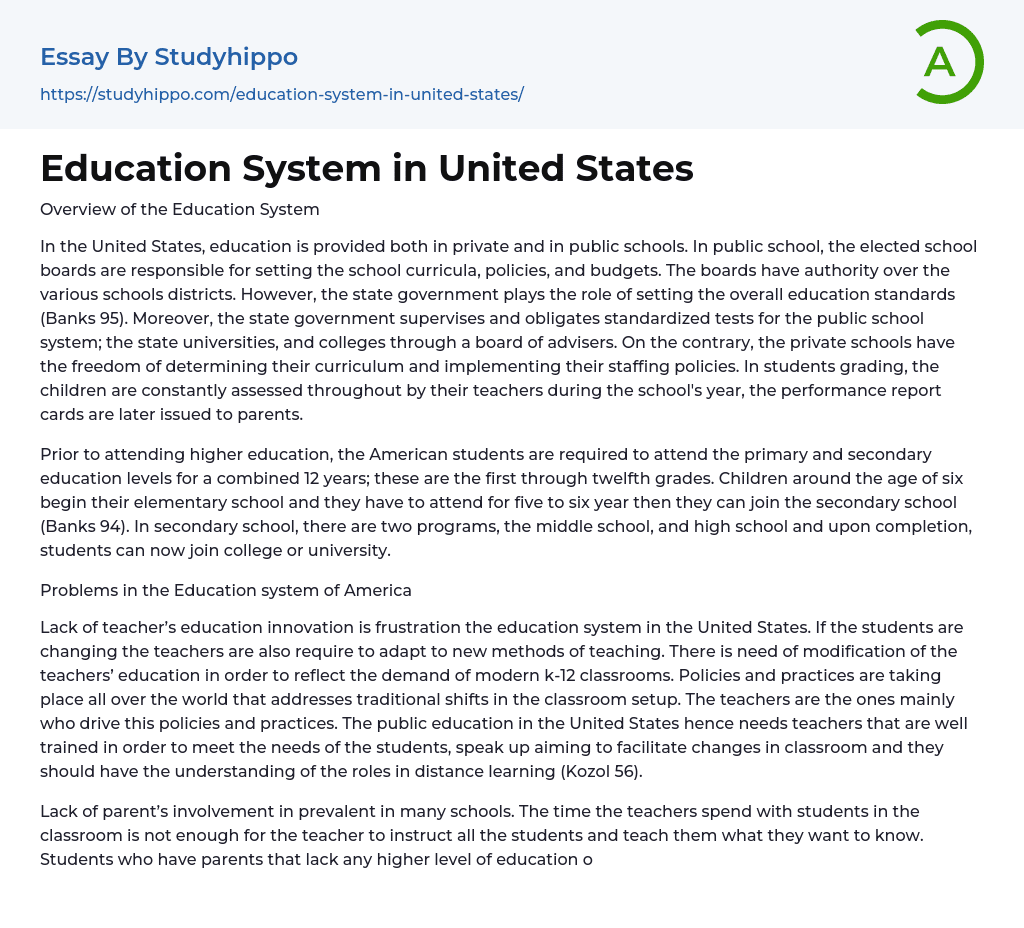Overview of the Education System
The education system in the United States is made up of both private and public schools. Public schools are overseen by elected school boards, which set curricula, policies, and budgets for school districts. These boards have authority over school districts. Conversely, state government is responsible for establishing education standards and administering standardized tests for public schools, state universities, and colleges through a board of advisers (Banks 95). In contrast, private schools have the autonomy to decide their own curriculum and staffing guidelines.
In the American education system, students are assessed by their teachers and given report cards to communicate with parents. To pursue higher education, students must finish 12 years of primary and secondary schooling from first grade to twelfth grade. Elementary school usually starts around six years old and lasts for five to six years before transition
...ing to secondary school (Banks 94). Secondary school includes middle school and high school programs, after which students can choose to attend college or university.
Challenges in the American Education System:
The education system in the United States is currently experiencing difficulties caused by a lack of innovation in teacher education. As students continue to develop, it is essential for teachers to adjust their teaching methods accordingly. Updating teacher training to meet the demands of modern K-12 classrooms is crucial. Different policies and practices are being introduced worldwide to address traditional shifts in classroom dynamics, with teachers playing a key role in driving these initiatives.
The United States' public education system requires skilled teachers who can meet students' needs, advocate for classroom changes, and handle distance learning challenges (Kozol 56). Many schools lack parental involvement, which hinders teachers
from providing comprehensive instruction and meeting all students' needs within limited class time. Students whose parents did not pursue higher education often struggle academically.
The career of students is often jeopardized due to excessive dependence on schools and lack of parental involvement in academic matters. Despite improvements in America's economy, there has been no noteworthy rise in school expenditure. The United States' education system still faces the aftermath of past economic downturns, with numerous states allocating less funding per student compared to pre-recession levels.
The reduction in the school budget is hindering both the improvement of graduation rates and the narrowing of the achievement gap (Kozol 56). It is crucial for schools to obtain additional funding, particularly considering a more stable economy. Many schools in the United States are presently grappling with overcrowding problems, as student enrollment surpasses capacity. As a result, packed classrooms lead to inadequate individualized attention from educators, impeding students' personal learning journeys. These extensive class sizes impede teachers' efficacy and create obstacles for students' comprehension.
The state government is responsible for establishing education standards and addressing issues in the education system. An effective strategy to enhance graduation rates involves increasing per student income by allocating additional budget. This can be achieved through the construction of more schools, which will mitigate overcrowding, improve teacher effectiveness, and enhance students' learning experience. Additionally, parents must recognize their role in their children's academic accomplishments.
Work Cited
- Banks, J. A., & Banks, C. A. M. (2009). Multicultural education: Issues and perspectives. John Wiley & Sons.
- Kozol, Jonathan. Savage inequalities: Children in America's schools. Broadway Books,
2012.
- History Of Education essays
- Graduate School essays
- Middle School essays
- School essays
- Special Education essays
- University essays
- Vocational Education essays
- College essays
- Student essays
- High School essays
- Elementary School essays
- Public School essays
- Single Sex Schools essays
- Kindergarten essays
- Teacher essays
- Classroom essays
- Examination essays
- E-Learning essays
- Homeschooling essays
- School Types essays
- Peer Group essays
- Professor essays
- Should College be Free essays
- Should college athletes be paid essays
- College Education essays
- College Tuition essays
- Graduation essays
- College Goals essays
- Personal Statement essays
- Online Classes Vs Traditional Classes essays
- Online Education essays
- Student Loan essays
- Study Abroad Scholarship essays
- Reasons To Go To College essays
- Paying College Athletes essays
- Technology In The Classroom essays
- Plans after High School essays
- High School Experience essays
- Classroom Management essays
- Bachelor's Degree essays
- MBA essays
- College Life essays
- Grade essays
- Diploma essays
- Academia essays
- Academic And Career Goals essays
- Academic Integrity essays
- Brainstorming essays
- Brown V Board of Education essays
- Brown Vs Board Of Education essays




